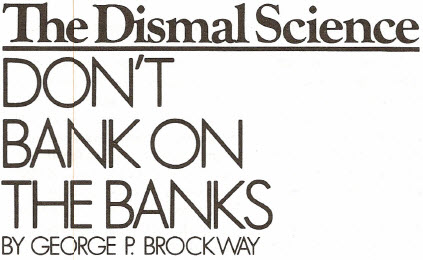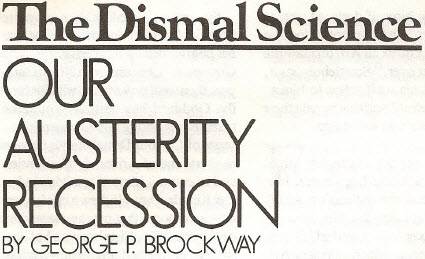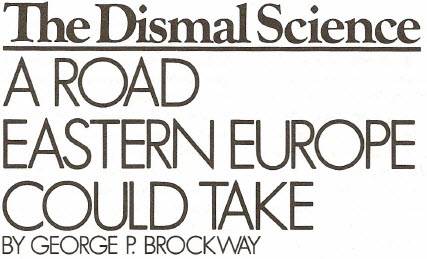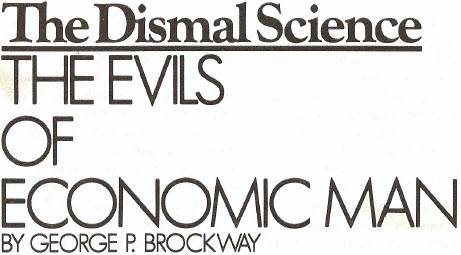By George P. Brockway, originally published February 11, 1991
I CAN’T THINK of a single good reason why the rest of the financial sector, led by the commercial banks, should not eventually follow the S&Ls to the woodshed. In a few cases the usual arguments about “the others” being more experienced or diversified may carry some weight, but in general their problems and those of the S&Ls have similar causes and will have similar consequences.
There is more than a trace of poetic justice here; the commercial banks lobbied hard for the deregulation that did in the S&Ls, and the same deregulation has returned to plague its champion.
Only 11 years ago, the states had usury laws that set the maximum interest rates for different loans. There were, of course, exceptions of various degrees of complexity, but the important point is that there were limits to what could be charged. The Federal Reserve Board set limits in the other direction, the most discussed being Regulation Q. To give the S&L’s a chance to survive, and to offset their being restricted essentially to home financing, Regulation Q allowed them to pay savings accounts a fraction of a point more than the commercial banks.
That system was a casualty of the Federal Reserve Board’s sensational and long-running battle with inflation (see “Who Killed the Savings and Loans?” NL, September 3, 1990). It took almost 30 years for the system to start to break down, and the collapse is not yet complete.
The reason for the long Untergang is the inherent stickiness of finance. In any 12months the nonfinancial sectors (public and private) make new borrowings equal to less than one-twelfth of their total indebtedness. The other eleven-twelfths includes 30-year mortgages still paying 4 per cent interest, 20-year Treasuries paying 15.75 per cent, credit card freaks paying 19.9 per cent, and all sorts of things in between.
With this big backlog (currently about $8.3 trillion), even very large shifts in the interest rate on new loans have only a lethargic effect on the nation’s overall interest rate. The overall rate was 9.55 per cent in 1979-when former Reserve Chairman Paul A. Volcker took well publicized command of the inflation battle-and reached 10.61 per cent a year later. As a result of Volcker’s policies, however, the average prime rate on new loans jumped from 12.67 per cent in 1979 to 15.27 per cent in 1980 and topped out at 21.5 per cent that December and the following January. Since what is comparatively slow going up is also comparatively slow coming down, the average interest rate is higher today than it was in 1980, although the prime is less than half its 1980 peak.
The stickiness of finance enabled the S&Ls and the commercial banks to withstand the surge of interest rates as long as they did. It is probable that the bankers (of all kinds) do not yet know what hit them; certainly the Federal Reserve Board (called the nation’s central bank by its present chairman, Alan Greenspan) does not know. So I’ll give them a hint. If they pay high interest to attract funds, they must charge high interest to cover their costs. And if businesses must pay high interest, they must charge high prices for their goods. At this point, the bubble gets very thin. Consumers do not have money to pay high prices, particularly if many have lost their jobs.
You can charge whatever amuses you for a book or a loaf of bread or a new broom to sweep things clean. Only the book or bread or broom business will be affected. But when you charge too much for the use of money (and it is the Federal Reserve Board that ultimately sets the rate), all businesses, all banks and insurance companies and “institutions,” and all men, women and children are affected.
The S&Ls were driven to the wall first, but the death march of the commercial banks is gathering momentum. Both S&Ls and commercial banks cheered when the state usury laws were suspended, and rushed to expand their real estate business. They are now suffering from a surfeit of residential condos, motor inns, office buildings, and shopping malls. The commercial banks greedily participated in the Great Recycling of OPEC’S profits and as a result will have to face up to their losses in the Third World. Many S&Ls and commercial banks have stuck themselves with junk bonds. How many will survive the recession?
Well, the Bush Administration proposes to help them by getting rid of two of the few remaining New Deal banking reforms. The most important of these keeps commercial banking separate from investment banking, insurance and especially ordinary business. The other restriction keeps commercial banks from branching out beyond a state’s borders.
In the cheery days of President Ronald Reagan, these regulations were anathema simply because they were regulations, and because, as some sports-minded journalist noticed, not one American bank ranked among the top 10 in the world. Even more shameful, most of the giant banks were Japanese. Once again it seemed that they knew something we didn’t know.
In the drearier economic days of President George Bush, less is said about the Japanese banks, for they have fallen on harder times. The index of leading stocks on the Japanese exchange fell 38.7 per cent in 1990, and the Japanese banks (this is one of the secrets of their size) have long positions in those stocks. They have long positions, too, in a rapidly falling real estate market, which they can speculate in (unlike American banks) as well as lend money on.
A few years ago, proposals to permit interstate Banking and to allow banks to own brokerage houses and insurance companies (and vice versa) would have caused a considerable hullabaloo. The large banks were in favor of changing everything; they wanted to get on that top 10 board with the Japanese. Likewise the big stock brokerage houses and insurance companies and all-in-one companies such as Sears, Roebuck. Smaller operators (except those who wanted to sell out for capital gains) preferred the existing conditions-although some would not have objected to dabbling in additional financial services, provided that other financial servers couldn’t dabble back.
Today, the Bush banking moves are not stirring much controversy. A professor of finance suggested recently in the New York Times that this is because they don’t go far enough, that there is nothing to shout about. But commercial banks are in trouble, and since the trouble is no longer confined to Texas and Oklahoma, there is little reason to expect greener pastures in other states. Nor is the solution to be found in putting them together with the problem plagued brokerage houses, insurance companies, pension funds, investment banks-and Sears, Roebuck. A couple of dozen such financial smorgasbords would likely result in a couple of dozen concentrated headaches, if not hemorrhages.
To be sure, the Administration promises to supervise the banks closely to prevent their making more bad loans. Does that mean they are not supervised closely now? Yes, it does. You see, supervision costs money, and you’ve heard about the deficit. Increased costs will have to be matched by increased taxes-in this case, Federal insurance fees. Higher insurance fees will mean lower interest on deposits, and that means money-market funds and Treasury bills will attract cash away from the banks. To keep their deposits, banks will have to pay higher interest, and to do that they’ll have to make more loans at high rates. Sound borrowers won’t pay high rates; so the banks will have to hunt for riskier deals (see “Big Is Ugly,” NL, September3, 1984). And that’s what got them where they are.
In short, interest rates aren’t innocent. If you refuse to control them, you destabilize the financial sector-and the whole economy. If you manipulate them in a fallacious attempt to contain inflation, you bring on recession (See “Bankers Have the Classic COLA,” NL, January 9, 1989). And that’s what the Federal Reserve has done.
A GOOD DEAL of the trouble lies in the fact that few bankers understand how the capitalist system differs from the mercantilist system. In Legal Foundations of Capitalism (one of the neglected great books),
John R. Commons explains the shift from property as use-value to property as exchange value. This did not start in the United States until the first Minnesota Rate Case a century ago, and most bankers are still out of date. They remain mainly interested in fixed assets that can be attached, not in going concerns that generate cash flow and profits. Hence their fatal fascination with real estate and the idiotic recycling that transformed OPEC profits into loans that are in effect gifts of American money to rulers of Third World nations.
Willard Butcher, when he was chairman of Chase Manhattan, once delivered himself of a perfect example of bankerly thinking: “Is Mexico worth $85 billion?” he asked rhetorically. “Of course it is. It has oil, gold, silver, copper. … “All these assets are physical. You can touch them, and you can attach them. But they aren’t worth much if they can’t be sold at a profitable price, and when usurious interest rates are charged profitable prices are impossible.
On an arguably more modest level, I came up against this sort of thinking at another bank while I was in the publishing business. The bank examined our balance sheet and advised us that our inventory was too low. Did we have an unusually large number of titles out of stock? I asked. No, on that point our record was exceptionally good. Did we allow titles to go out of print too quickly? No, rather the contrary. Were we slow to fill orders? No, again. Our record here was the best the bank knew of. Did our practice of printing in relatively small quantities (this was before the Japanese made “just in time” inventory control famous) result in significantly higher unit costs? No, yet again.
You’d have to say that we were managing our inventory as well as anyone in publishing. Nevertheless, the bank insisted it was too low. The unspoken (or unrecognized) reason was that our low inventory meant we did not have much for the bank to attach if we got in trouble. It never crossed the bank’s mind that too much money tied up in inventory might get us in trouble, and that if we couldn’t sell the inventory profitably, the bank certainly would be unable to do so.
Commercial bankers aren’t the only people still living in a precapitalist world. Our financial system as a whole (S&Ls, banks, insurance companies, pension funds, “institutions” and supervisors) continues to be essentially mercantilist. Its ideal profit, like Bush’s, is a capital gain. In this understanding it is joined by mainstream economics, which analyzes business as a disconnected series of market-clearing ventures, not as a going concern. Until these two powerful sectors of our society are brought into the modern world, stagnation, punctuated by bankruptcies, is likely to be our lot.
The New Leader








